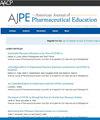Preparing NAPLEX-Ready Graduates Requires Collaboration to Optimize Success
IF 3.5
4区 教育学
Q1 EDUCATION, SCIENTIFIC DISCIPLINES
引用次数: 0
Abstract
Declining NAPLEX pass rates are prompting widespread discussions and urgent investigations into potential causes, including an examination of PharmD program characteristics, curriculum, student preparedness, and an evolving exam blueprint. Many studies have been conducted to understand the association of various factors with NAPLEX success, and individual programs have attempted to address these factors with mixed results. It is time to include additional stakeholders and collaborate on solutions. The National Association of Boards of Pharmacy (NABP), Accreditation Council for Pharmacy Education (ACPE), American Association of Colleges of Pharmacy (AACP), and PharmD programs (including preceptors and students) are all invested in and may influence NAPLEX outcomes. Specific recommendations for the NABP and the ACPE include increasing transparency regarding the timing and process of exam blueprint changes, coordinating a structured crosswalk between ACPE standards and NAPLEX content, and considering overall pass rates as a measurable outcome of program quality. PharmD programs should consider strategies such as engaging preceptors in exam preparation and providing proactive, structured student support for skills such as time management. Collectively, AACP members can leverage their expertise to develop shared resources, such as a practice question bank. Enhancing alignment between education and licensure ensures that pharmacy graduates are prepared for practice, ultimately benefiting patient care.
准备NAPLEX®-Ready毕业生需要协作以优化成功。
不断下降的NAPLEX®通过率引起了广泛的讨论和对潜在原因的紧急调查,包括对药学博士(PharmD)项目特征、课程内容、学生准备和不断发展的考试蓝图的考试。已经开展了许多研究,以了解与NAPLEX®成功的因素之间的关系,并且个人计划试图解决这些因素,结果好坏参半。现在是时候让更多的利益相关者参与进来,共同制定协作解决方案了。全国药学委员会协会(NABP)、药学教育认证委员会(ACPE)、美国药学学院协会(AACP)和药学博士课程(包括教师和学生)都投资于NAPLEX®,并可能影响NAPLEX®的结果。NABP和ACPE的具体建议包括增加有关考试蓝图更改的时间和过程的透明度,协调ACPE标准和NAPLEX®内容之间的结构化交叉通道,并考虑将总体通过率作为项目质量的可衡量结果。药学博士课程应该考虑一些策略,比如让导师参与备考,并在时间管理等技能方面为学生提供主动的、有组织的支持。总的来说,AACP成员可以利用我们的集体专业知识来开发共享资源,如练习题库。加强教育和执照之间的一致性确保药房毕业生为实践做好准备,最终有利于患者护理。
本文章由计算机程序翻译,如有差异,请以英文原文为准。
求助全文
约1分钟内获得全文
求助全文
来源期刊
CiteScore
4.30
自引率
15.20%
发文量
114
期刊介绍:
The Journal accepts unsolicited manuscripts that have not been published and are not under consideration for publication elsewhere. The Journal only considers material related to pharmaceutical education for publication. Authors must prepare manuscripts to conform to the Journal style (Author Instructions). All manuscripts are subject to peer review and approval by the editor prior to acceptance for publication. Reviewers are assigned by the editor with the advice of the editorial board as needed. Manuscripts are submitted and processed online (Submit a Manuscript) using Editorial Manager, an online manuscript tracking system that facilitates communication between the editorial office, editor, associate editors, reviewers, and authors.
After a manuscript is accepted, it is scheduled for publication in an upcoming issue of the Journal. All manuscripts are formatted and copyedited, and returned to the author for review and approval of the changes. Approximately 2 weeks prior to publication, the author receives an electronic proof of the article for final review and approval. Authors are not assessed page charges for publication.

 求助内容:
求助内容: 应助结果提醒方式:
应助结果提醒方式:


